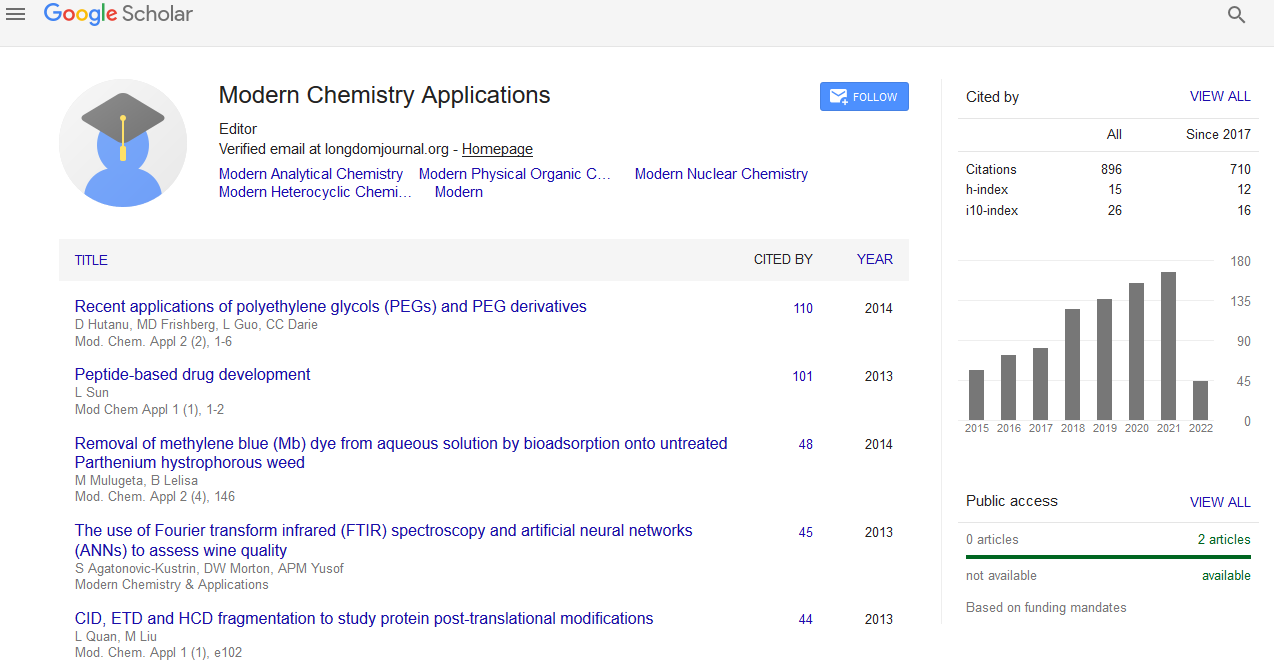Indexed In
- Open J Gate
- JournalTOCs
- RefSeek
- Hamdard University
- EBSCO A-Z
- OCLC- WorldCat
- Scholarsteer
- Publons
- Geneva Foundation for Medical Education and Research
- Google Scholar
Useful Links
Share This Page
Journal Flyer

Open Access Journals
- Agri and Aquaculture
- Biochemistry
- Bioinformatics & Systems Biology
- Business & Management
- Chemistry
- Clinical Sciences
- Engineering
- Food & Nutrition
- General Science
- Genetics & Molecular Biology
- Immunology & Microbiology
- Medical Sciences
- Neuroscience & Psychology
- Nursing & Health Care
- Pharmaceutical Sciences
Synthesis, structural characterization and DFT studies of coordination polymers with nitrogen based ligands
5th Global Chemistry Congress
September 04-06, 2017 | London, UK
J Ngoune, J Nenwa, G Djimassingar, A D Tayo, T J M-M Ntep, T R Fomuta, O N Ngnabeuye, A L Djoumbissie, A C T Kuate, C Pettinari and A Eleuterio
University of Dschang, Cameroon
University of Yaounde I, Cameroon
Mongo Polytechnique University Institute, Tchad
University of Camerino, Italy
Instituto de Investigaciones Quimicas, Spain
Posters & Accepted Abstracts: Mod Chem Appl
Abstract:
Coordination polymer or Metal-Organic Frameworks (CP/MOFs), which are generally obtained by (self)-assembling of oligonuclear metal clusters (the so-called Secondary Building Units or SBUs), are the subjects of an increasing number of studies due to their interesting properties and promising applications in numerous important fields, such as gas storage, molecular recognition and catalysis.[1] An interesting class of polynucleatingappropriate ligands able to drive the self-assembly of MOFsis represented by N-donor units containing two moieties interconnected by various spacers. Such ligand can afford different lengths, present linear or non-linear geometries and exhibit conformationally rigid or flexible molecular skeletons withan infinite one-(1D), two-(2D) or three-(3D) dimensional framework or periodic nets.[2] Yaghiet al. have successfully developed porous materials (such as metal carboxylate) with controllable shape and size of the cavities.[3] Some of these metal carboxylates appeared to have unusual magnetic properties [4a] while others exhibited high efficiency for gas absorption such as dihydrogen and dinitrogen. In this context, we have designed, synthesized and characterized new CP/MOFs by treatment ofthe trinuclear core[Cu3(μ- C3H3N2)3(μ3-OH)(H3CCOO)2(C3H4N2)] (A) [4b] with different either rigid or flexibleN-donor containing ligands.One of the targeted species, the supramolecule[Cu3(4,4�??-bipy)(HCOO)(HO)(μ-4,4�??-bipy)2(μ3-OH) (μ-pz)3]�??.nH2O (C), obtained by reaction of SBU with 4,4�??-bipyridine (B), consists of a 3D supramolecular material, in which themonomeric unitsare connected bynon-covalent bonds such as �?-�? stacking intermolecular interactions and/or C-H�?��? and C-H�?�O weak contacts. In this contribution, we will present the fascinating waved channel structural architecture exhibited by these compounds, which are CP/MOFs or supramolecular self-assembly.The aptitude of the dinitrogen ligandtake-upof theseMetal-Organic- Frameworks will be discussed.


